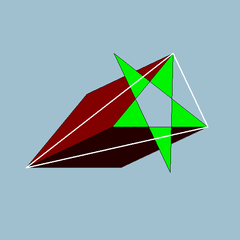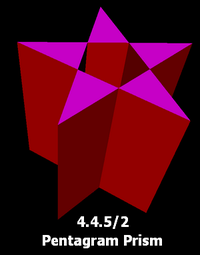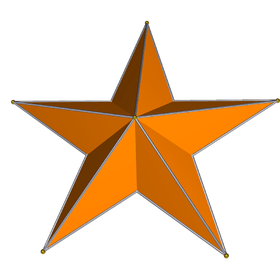Pentagrammic prism
| Uniform Pentagrammic prism | |
|---|---|
 | |
| Type | Prismatic uniform polyhedron |
| Elements | F = 7, E = 15 V = 10 (χ = 2) |
| Faces by sides | 5{4}+2{5/2} |
| Schläfli symbol | t{2,5/2} or {5/2}x{} |
| Wythoff symbol | 2 5/2 | 2 |
| Coxeter-Dynkin | |
| Symmetry | D5h, [5,2], (*552), order 20 |
| Rotation group | D5, [5,2]+, (552), order 10 |
| Index references | U78(a) |
| Dual | Pentagrammic dipyramid |
| Properties | nonconvex |
 Vertex figure 4.4.5/2 | |
In geometry, the pentagrammic prism is one in an infinite set of nonconvex prisms formed by square sides and two regular star polygon caps, in this case two pentagrams.
This polyhedron is identified with the indexed name U78 as a uniform polyhedron.
It is a special case of a right prism with a pentagram as base, which in general has rectangular non-base faces.
Note that the pentagram face has an ambiguous interior because it is self-intersecting. The central pentagon region can be considered interior or exterior depending on how interior is defined. One definition of interior is the set of points that have a ray that crosses the boundary an odd number of times to escape the perimeter.
In either case, it is best to show the pentagram boundary line to distinguish it from a concave decagon.
Gallery
 An alternative representation with hollow centers to the pentagrams. |
 The pentagrammic dipyramid is the dual to the Pentagrammic prism |
External links
- Weisstein, Eric W., "Pentagrammic prism", MathWorld.
- Weisstein, Eric W., "Pentagrammic dipyramid", MathWorld.
- http://www.mathconsult.ch/showroom/unipoly/78.html
- http://bulatov.org/polyhedra/uniform/u03.html
- Paper model of pentagrammic prism
- http://www.math.technion.ac.il/~rl/kaleido/data/03.html
- http://home.comcast.net/~tpgettys/nonconvexprisms.html
- http://www.ac-noumea.nc/maths/amc/polyhedr/no_conv5_.htm
- Paper Model (net) Pentagrammic Prism